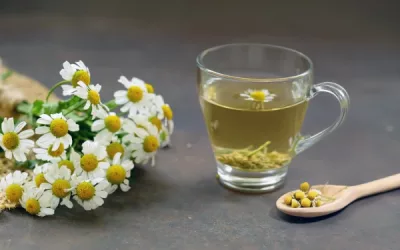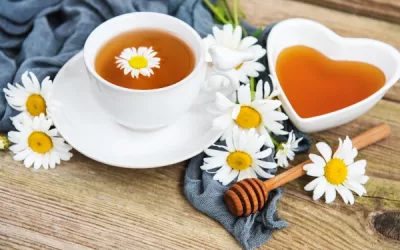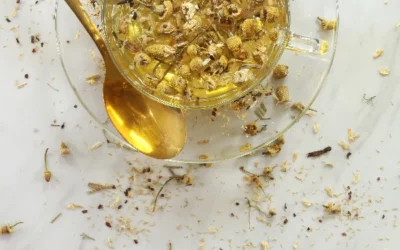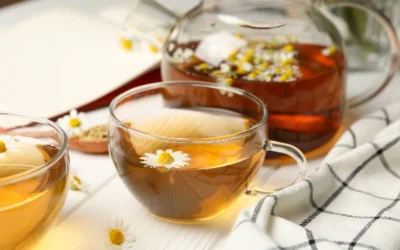Did you know that chamomile tea has been cherished for thousands of years, not just for its soothing flavour but also for its numerous health benefits? As tea enthusiasts and health-conscious individuals increasingly seek natural remedies for anxiety and sleep issues, understanding the nuances of chamomile tea becomes essential. This guide will unravel the origins, health benefits, and best brewing techniques of chamomile tea, helping you discover the finest options available. Join us on this aromatic journey to find the best chamomile tea for relaxation!
Table of Content
- What are the origins and types of chamomile tea?
- How should chamomile tea be brewed for optimal flavour?
- What are the flavour profiles of different chamomile teas?
- Are there any side effects of drinking chamomile tea?
- How often can you safely drink chamomile tea?
- What are some popular chamomile tea recipes?
- Conclusion
What are the origins and types of chamomile tea?
Chamomile tea has a rich history that dates back to ancient times. It’s derived from the flowers of the chamomile plant, which belongs to the daisy family.
The two main types of chamomile used for tea are German chamomile (Matricaria chamomilla) and Roman chamomile (Chamaemelum nobile). Both types have distinct characteristics and historical uses.
German chamomile is the more common variety, known for its slightly sweet, apple-like flavour.
Roman chamomile, on the other hand, has a more robust, earthy taste.
Historically, chamomile has been valued for its medicinal properties and was used by ancient Egyptians, Greeks, and Romans. These cultures believed chamomile could treat various ailments, from digestive issues to skin conditions.
The chamomile plant is resilient and can be found in Europe, North America, and Asia. Its daisy-like flowers are harvested and dried to make herbal infusions, which are celebrated for their calming effects.
Chamomile tea holds cultural significance as a natural remedy for anxiety and sleep disorders. The production of chamomile tea involves harvesting the flowers, drying them thoroughly, and then brewing them to release their aromatic compounds.
What are the main types of chamomile tea?
Chamomile tea comes in two primary varieties, each with unique attributes and benefits:
- German Chamomile (Matricaria chamomilla)
- Sweet, apple-like flavour
- Commonly used in herbal remedies
- Known for its anti-inflammatory properties
- Popular for treating digestive issues
- Roman Chamomile (Chamaemelum nobile)
- Earthy, robust taste
- Often used in essential oils
- Known for its soothing effects on the skin
- Less common for tea but still effective
Both types of chamomile tea are effective in promoting relaxation and sleep. They are often chosen based on flavour preference and specific health benefits.
If you’re looking for a sweet and mild flavour, German chamomile is a great choice. For a more robust and earthy taste, Roman chamomile might be your go-to.
How is chamomile tea traditionally used?
Chamomile tea has a long-standing tradition of being used for its medicinal and therapeutic benefits. Throughout history, people have turned to chamomile tea for various purposes:
- As a Sleep Aid: Known for its calming properties, it’s traditionally consumed before bedtime to promote better sleep.
- Digestive Health: It helps soothe stomach aches and aids digestion.
- Skin Health: When applied topically, chamomile can help treat skin conditions like eczema and inflammation.
- Stress Relief: The tea is often used to reduce stress and anxiety levels.
- Cold Remedy: Chamomile tea can help alleviate symptoms of the common cold and sore throat.
Its traditional use varies across cultures, but the common thread is its role in promoting relaxation and well-being. Whether you’re sipping it to unwind after a long day or to soothe an upset stomach, chamomile tea has been a trusted ally for centuries.
What are the production methods for chamomile tea?
The production methods for chamomile tea are carefully designed to preserve the delicate flavours and beneficial properties of the chamomile flowers. Here’s how it’s typically done:
- Harvesting: Chamomile flowers are handpicked at peak bloom for the best quality.
- Drying: The flowers are then dried, either through air drying or with low heat, to retain their essential oils.
- Blending: The dried flowers are sometimes blended with other herbs or teas to create unique flavours.
- Packaging: The final product is packaged in tea bags or loose-leaf form for brewing.
These steps ensure that chamomile tea maintains its aromatic qualities and therapeutic benefits. When you brew a cup of chamomile tea, you’re experiencing a process that’s been refined over centuries.
In ancient Egypt, chamomile was so revered that it was dedicated to the sun god Ra. Egyptians used chamomile not only as a medicinal herb but also in their embalming process and to honour the dead.
The flower’s association with the sun and its healing properties made it a significant part of their culture. This historical reverence highlights chamomile’s deep roots in human history and its lasting appeal.
I remember my grandmother always had a pot of chamomile tea brewing on the stove. She believed in its power to heal and calm. Whenever I felt under the weather or couldn’t sleep, she would pour me a warm cup and sit with me, sharing stories of her childhood in the countryside.
Those moments taught me the comfort and care a simple cup of chamomile tea could provide. To this day, chamomile tea is my go-to remedy for life’s little stresses.
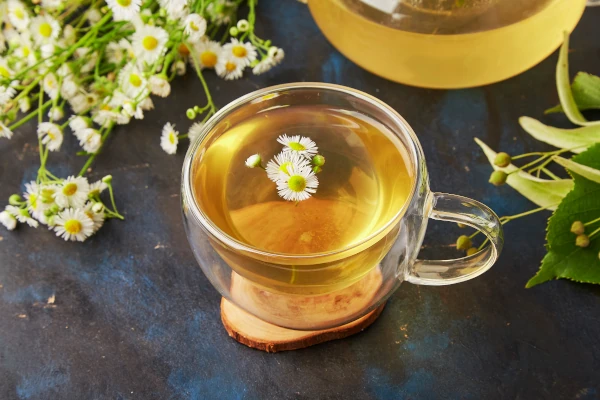
How should chamomile tea be brewed for optimal flavour?
Let’s dive into the art of brewing the perfect cup of chamomile tea, shall we? For tea aficionados and the curious souls wandering through the world of herbal infusions, nailing the perfect flavour is a game-changer. It’s like finally hitting the right note in your favourite song.
When it comes to chamomile tea, the basics boil down to three main factors: water temperature, steeping time, and whether to use fresh or dried flowers. Oh, and let’s not forget the equipment and some pro tips sprinkled in for good measure to avoid common pitfalls.
What is the ideal steeping time for chamomile tea?
Alright, imagine your chamomile tea is like Goldilocks—neither too weak nor too strong, but just right. The sweet spot for steeping chamomile is about 5 to 7 minutes. Longer than that and it starts getting a bit too bitter, like that one friend who overstays their welcome.
Understeep it, and you’re left with a watery mess that’s about as exciting as soggy crackers.
- Steep time: 5 to 7 minutes
- Taste profile: Floral, mildly sweet
- Don’t rush it: Give it time to release those essential oils
- Avoid bitterness: Don’t go overboard on the steeping
- Achieve balance: This timing gets you the ideal balance of aroma and flavour
Steeping for the right amount of time brings out the best in chamomile, giving you that perfect, soothing flavour without any unpleasant tang.
Should I use fresh or dried chamomile flowers?
You might be wondering if you should go fancy with fresh flowers or stick to the tried-and-true dried ones. Short answer: both work, but it depends on your vibe and what’s available.
Fresh flowers give a more intense, vibrant flavour, but drying them doesn’t fall far behind and adds a bit of convenience into the mix.
- Fresh flowers: Intensely aromatic, vibrant flavour
- Dried flowers: Convenient, accessible, stable flavour
- Storage: Fresh needs refrigeration; dried can chill in your pantry
- Availability: Fresh might be seasonal; dried is year-round
- Cost: Fresh could be pricier; dried is often more budget-friendly
The choice between fresh and dried flowers is like deciding between having a fancy meal out or a comfy home-cooked dinner. Each has its charm.
What equipment is best for brewing chamomile tea?
Now, let’s talk gear. Brewing chamomile tea doesn’t require any wizardry, but using the right equipment can elevate your tea game. First thing’s first – you need a good kettle for heating water.
Control over the temperature is clutch because too hot boils the chamomile to death, while too cool leaves it like sad bathwater.
- Kettle: Electric with temperature control
- Teapot or mug: One with a lid to trap the heat
- Infuser: Stainless steel mesh or a tea ball
- Timer: Keep track of that 5 to 7-minute steep time
- Fresh water: Always use filtered or bottled for the best taste
Using the right tools not only simplifies the brewing process but also ensures you extract the full essence of the chamomile flowers. Plus, having a fun teapot or fancy infuser is a great conversation starter—trust me on this one.
During the 18th century, chamomile became a significant herbal remedy in Europe. The ancient Romans were particularly fond of it, using its calming properties to ease digestive and sleep problems.
Emperor Marcus Aurelius, known for his stoic philosophy, was a fan of chamomile tea to help calm his mind after toga-wearing Senate debates. The practice of drinking chamomile tea for its health benefits has undoubtedly withstood the test of time, from emperors to everyday tea enthusiasts like you and me.
So, go ahead, brew a cup with a little bit of historical flair in mind.
What are the flavour profiles of different chamomile teas?
Chamomile tea is the herbal wonder that promises to whisk you away to a field of flowers and calm your nerves like a charm. Made from dried chamomile flowers, this tea is a fan-favourite for its mild yet distinct flavour. However, the taste can vary wildly depending on the specific type and the brand you choose.
At its core, chamomile tea flaunts a delicate sweetness, reminiscent of warm honey. Floral notes permeate each sip, giving it an aromatic appeal. Some varieties bring a hay-like undertone, making you feel as though you’re walking through a sunlit meadow.
But that’s not all; you can elevate this already charming brew with ingredients like honey, lemon, or even a pinch of lavender for added pizzazz. Now, let’s dive into how the flavour morphs between different brands and additional ingredients.
How does the flavour vary between brands?
Okay, so you’re in the tea aisle, and there are five different brands all promising the “best chamomile tea.” Spoiler alert: not all chamomile teas are created equal.
- Teapigs: Known for a strong floral essence and a rich, almost honey-like sweetness.
- Twinings: Offers a milder, more balanced flavour with a slightly sweet, hay-like undertone.
- Celestial Seasonings: Slightly bolder in taste with fruity nuances; great for those who like their chamomile with a bit of zest.
- Traditional Medicinals: Medicinal, with a fuller body that carries a bit more bitterness.
- Harney & Sons: Elegant and subtly sweet, perfect for a refined tea experience.
It’s evident different brands bring their own spin to chamomile tea, enhancing or muting different flavour notes. It’s all about personal preference, folks! Try a few and find your perfect match.
Brands bridge the gap between “meh” and “wow”. It all boils down to how the flowers are harvested, dried, and packaged. Remember, the best chamomile tea might not be the most expensive one—sometimes simplicity is key.
What can be added to chamomile tea to enhance its flavour?
If chamomile’s subtle elegance isn’t enough for your taste buds, worry not. Enhancing the flavour is as easy as raiding your kitchen.
- Honey: Adds warmth, sweetness, and depth.
- Lemon: Perfect for a citrusy kick and extra zing.
- Lavender: Elevates your tea with more floral notes, pairing well with the inherent chamomile aroma.
- Mint: For a refreshing twist and a cooling effect.
- Ginger: Great for a spicy, warming touch.
Experimenting with these additions could turn your chamomile tea into a unique concoction tailored just for you. Each ingredient brings its own personality, making every cup an adventure. Don’t be afraid to mix and match; your perfect blend might just be one spoonful away.
What are the tasting notes of the best chamomile teas?
Now we’re getting to the good stuff. Let’s talk tasting notes.
- Sweetness: A good chamomile tea should have a natural sweetness, reminiscent of honey.
- Floral: The floral notes are what give chamomile its standout character.
- Hay-like: Earthy and grounding, akin to sunshine on a hay field.
- Fruity: Some high-quality teas even carry subtle fruit undertones, like apple or nectarine.
- Balanced: The best chamomile teas are well-balanced, not too overpowering in any one flavour aspect.
These tasting notes can make even the pickiest tea drinker smile. Whether you’re seeking something deeply calming or slightly earthy, the best chamomile tea should deliver a harmonious and pleasing experience.
In the hustle and bustle of ancient Rome, a similar love for herbal concoctions was evident. Romans were avid tea enthusiasts long before chamomile gained its current popularity. They often sipped on herbal teas, much like we enjoy chamomile today, to treat ailments and provide comfort.
Even Emperor Marcus Aurelius, known for his wisdom and stoic philosophy, would indulge in herbal brews to soothe his mind after a day of ruling. Evidently, the quest for the perfect blend of herbs in tea transcends centuries, promising not just a taste of flavour, but a sip of tranquillity.
Are there any side effects of drinking chamomile tea?
Sure, chamomile tea is often praised as a magical elixir for stress and insomnia-busting. But let’s keep it real – even the best chamomile tea isn’t without its quirks and potential down-sides.
Chamomile tea has its fair share of loyal fans and sceptics alike. This beloved brew might be your nightly go-to, but it’s wise to know that it can cause a few bumps for some folks. Let’s spill the (chamomile) tea on its possible side effects and interactions you should be mindful of before you drink it up.
Who should avoid chamomile tea?
Not everyone should dump a heap of chamomile buds into hot water. Some individuals should definitely steer clear.
- Pregnant women: Chamomile can impact hormone levels and might not be safe during pregnancy.
- People with seasonal allergies: If you’re allergic to ragweed and its plant cousins, chamomile could set off reactions.
- Infants and toddlers: The digestive systems of the little ones might not handle chamomile well, leading to irritations.
- People with asthma: Chamomile might trigger asthma symptoms in susceptible individuals.
- Those on blood thinners: Chamomile can have blood-thinning effects, which might double down on your prescribed meds.
Simply put, if you fall into any of these categories, perhaps avoid pouring yourself another cup of chamomile tea and consider consulting a professional instead.
What are the common side effects of chamomile tea?
You’d think a cup of tea couldn’t harm a fly, but chamomile has its own mischief list to consider.
- Allergic reactions: Ranging from skin rashes to anaphylaxis in severe cases.
- Drowsiness: Too much chamomile can make you feel like you’ve been hit with a tranquiliser dart.
- Nausea and vomiting: Might sound ironic for a beverage often used to settle the stomach.
- Eye irritation: Surprisingly, using chamomile tea directly on your eyes can cause redness and irritation.
- Breathing difficulties: If you’re prone to pollen allergies, this can affect your breathing.
In short, if you experience any of these delightful side effects, perhaps it’s time to revaluate your chamomile habit.
Can chamomile tea interact with medications?
Yep, it can! Chamomile tea isn’t just a harmless herbal remedy – it’s a pharmacist’s nightmare if mixed with the wrong meds.
- Blood thinners: Warfarin and chamomile? Not a match made in heaven due to the risk of increased bleeding.
- Sedatives and antidepressants: Mixing these can amplify drowsiness, making you feel like you’re swimming in molasses.
- NSAIDs: Chamomile might increase the risk of bleeding when taken with non-steroidal anti-inflammatory drugs.
- Diabetes medications: It might alter your blood sugar levels, leading to unexpected dips or spikes.
- Hormone therapy drugs: The hormonal effects of chamomile might interfere with your meds.
Better safe than sorry – if you’re on any of these medications, it’s wise to chat with your doctor before cosying up with a steaming cup of chamomile tea.
Back in ancient Egypt, chamomile was so revered for its medicinal properties that it was dedicated to the gods and placed in the tombs of pharaohs. That’s right, even the mighty rulers of Egypt believed in chamomile’s power to cure common colds, calm nerves, and even ward off evil spirits.
However, ancient wisdom didn’t come with a warning label – maybe they should have included a note on contraindications in those hieroglyphics. So, take a leaf from history: enjoy your chamomile tea, but know its strengths and limitations.
How often can you safely drink chamomile tea?
Chamomile tea, that golden elixir of calm and comfort, is a staple in many households. You might be thinking, “Can I chug this every day, or do I need to pump the brakes?” Well, let’s delve into the recommended intake, why it’s good for you, and if there’s a chance you could overdo it.
How many cups of chamomile tea can I drink per day?
First off, how many cups are we talking? The general consensus is that 1 to 4 cups per day is perfectly fine. Chamomile tea is gentle on your system, so you won’t be walking a tightrope just by enjoying a few steamy mugs.
- Standard potion: 1-4 cups a day.
- Soft and calming: Great for unwinding.
- Highly individual: Everyone’s tolerance varies.
- Advisable moderation: Listen to your body.
- Non-habit-forming: Much better than caffeine.
So, go ahead and sip away. Just remember, listening to your body is your best guide.
Is it safe to drink chamomile tea every day?
You’re probably wondering if daily chamomile consumption is the ticket to bliss or a fast track to dependency city. Good news! Drinking chamomile tea every day is safe for most people. It’s not like caffeine where you start shaking if you miss a cup.
- Calm-combo: Alleviates anxiety.
- Sleep-helper: Promotes better sleep quality.
- Digestive-helper: Eases stomach discomfort.
- Safe diet-addition: Generally non-reactive.
- Soothes allergies: Helps with minor ailments.
There you have it. Make chamomile tea your daily go-to without worry.
What are the benefits of regular chamomile tea consumption?
Alright, let’s talk perks. Chamomile tea isn’t just a tasty nightcap; it’s packed with health benefits that can make your regular tea fix feel like a health ritual.
- Anxiety relief: Natural relaxant.
- Insomnia aid: Regulates sleep patterns.
- Digestive health: Reduces bloating and nausea.
- Immune booster: Rich in antioxidants.
- Skin benefits: Anti-inflammatory properties.
Imagine, all these benefits for just sipping on a cup of delightful flowers. It’s almost like the universe wants you to have a chamomile tea habit.
In the whirlwind of 16th-century England, Queen Elizabeth I was a notorious insomniac. Amid the political turmoil and off-with-their-heads drama, she found solace in a nightly cup of chamomile tea.
It was said that her physician prescribed it to combat her chronic sleep issues and ease her stress from ruling the empire.
If an embattled monarch could find peace in a cup, surely, a good chamomile brew can work wonders for the rest of us. So, pour yourself a cup, lean back, and let those centuries-old royal vibes of calm drift over you. Cheers!
What are some popular chamomile tea recipes?
Alright, let’s dive into the aromatic world of chamomile tea. We’re not just talking about your plain, old chamomile tea bags floating in hot water. Oh no, we’re delving into creative concoctions like chamomile blends, iced delights, and even desserts. Buckle up, let’s talk recipes.
First off, chamomile tea isn’t just chamomile tea. It’s a versatile base that can be jazzed up in numerous ways. Think of it as the blank canvas of the tea world.
What are some unique chamomile tea blends?
You wouldn’t believe the funky combinations you can come up with by blending chamomile with other herbs and teas. Here are some blends that’ll make your taste buds do a little happy dance:
- Mint Chamomile Blend – A refreshing mix that combines the soothing nature of chamomile with the zing of mint.
- Lavender Chamomile Tea – Perfect for when you need to calm yourself positively into a zen mode.
- Chamomile and Green Tea – Get the best of both worlds: relaxation from chamomile and a slight energy boost from green tea.
- Chamomile Hibiscus Delight – A floral fusion that’s both beautiful and tasty, with a tart twist from the hibiscus.
- Apple Chamomile Tea – The sweet apple notes blend seamlessly with the calmness of chamomile for a fruity experience.
If you’re like me, you love a good experiment. These blends not only tantalise your taste buds but maximise the soothing effects chamomile is famous for.
How can I make iced chamomile tea?
Nothing says “refreshment” quite like iced chamomile tea. It’s super easy and perfect for those hot summer days when a hot brew would melt you faster than an ice cream in an oven. Here’s how you can make it like a pro:
- Ingredients:
- Chamomile tea bags or loose tea
- Honey or preferred sweetener
- Lemon slices or mint leaves (optional)
- Directions:
- Brew your chamomile tea stronger than usual, using twice the amount of tea bags.
- Let it steep then cool. You don’t want to be gulping down boiling water.
- Sweeten to taste. Sugar, honey, or even stevia works.
- Chill it in the fridge and serve over ice.
- Garnish with lemon slices or mint leaves, because you’re fancy like that.
The best part is, you can always experiment with additional flavours. Try adding a splash of fruit juice or a few berries for a dramatic twist.
Are there any dessert recipes using chamomile tea?
Chamomile tea isn’t just for sipping—it’s a secret weapon in the dessert world. Infusing chamomile into desserts elevates them to gourmet status. Here’s how you can do that:
- Chamomile Panna Cotta – Creamy, dreamy, and infused with the delicate flavour of chamomile.
- Chamomile-Infused Honey – Drizzle it over everything, from yoghurt to toast.
- Chamomile Ice Cream – Perfect for summer, combining creamy texture with a unique floral twist.
- Chamomile Shortbread Cookies – Adding a hint of relaxation to your tea-time snacks.
- Chamomile Poached Pears – A sophisticated treat that’s easier to make than it sounds.
Chamomile-infused desserts are like a warm hug from the inside out. You’ll feel like a culinary genius whipping these beauties up.
Back in the 18th century, the Georgians (the ones from the UK, not the American state) were all about tea, but they also had a sweet spot for desserts. The legendary chef Marie-Antoine Carême, possibly the world’s first celebrity chef, would often incorporate floral notes into his delicate confections.
While there’s no record of him using chamomile specifically, it’s safe to say he’d probably nod in approval of these creative blends.
So, the next time you’re in the kitchen, looking to elevate a meal or just your spirits, remember that chamomile tea is more than just a mild, floral brew. It’s your ticket to a world of culinary innovation, whether you’re blending, icing, or dessert-ing. Cheers to that!
Conclusion
As I reflect on the rich tapestry of chamomile tea that I’ve uncovered, it’s clear that this gentle infusion offers an abundance of benefits that go far beyond its soothing flavour.
From tracing its historical roots to exploring the various types and their unique qualities, we’ve seen how German and Roman chamomile both bring distinct aromas and traditional uses that have endured through the ages.
The health advantages—from its calming effects to digestive support—are well-supported by scientific studies, justifying why so many of us turn to it in times of stress.
Moreover, the intricacies of brewing reveal that mastering the art of chamomile tea is both a science and a pleasure. The perfect steeping time, paired with the right ingredients, allows us to unlock delightful flavour profiles.
Each cup can transform into a personalised experience, enhanced by the thoughtful selection of brands, each promising their own unique bouquet of taste.
Yet, as with all good things, moderation is vital. Recognising the potential side effects and being aware of interactions with medications are important steps in making chamomile tea a safe companion in our daily routines.
With careful consideration of personal health circumstances, drinking chamomile tea can indeed be a calming habit that many enjoy without concern.
So, what comes next? Perhaps I encourage you to experiment with the suggestions—try brewing a cup at the end of a long day or whip up one of the chamomile-infused recipes mentioned. We’ve only skimmed the surface of what this humble herb can offer.
In a world so quick-paced, taking the time to indulge in something as simple as chamomile tea can serve not just as a remedy for our anxieties, but as a reminder of the serene moments we can create in our lives.
After all, as the poet Rumi said, “The wound is the place where the Light enters you.” Let chamomile be that light in your pursuit of relaxation and well-being.
Resources
- The Effect of Oral Chamomile on Anxiety: A Systematic Review of Clinical Trials
- A Comprehensive Study of Therapeutic Applications of Chamomile
- The effects of chamomile extract on sleep quality among elderly people
- Effects of chamomile (Matricaria chamomilla L.) on sleep: A systematic review and meta-analysis
- A narrative review on the potential therapeutic benefits of chamomile
- Chamomile: A herbal medicine of the past with bright future
- A review of the bioactivity and potential health benefits of chamomile
- Chamomile (Matricaria chamomilla L.): A Review of Ethnomedicinal Use, Phytochemistry and Pharmacological Uses
- Effects of chamomile (Matricaria chamomilla L.) on sleep: A systematic review


